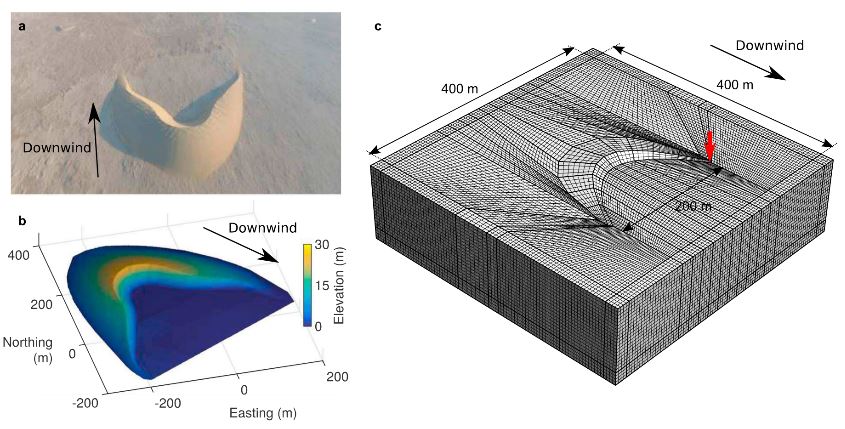30 July 2018
Study reveals how sand dunes alter seismic waves
Posted by larryohanlon
By Larry O’Hanlon
Sand dunes may be lovely to behold, but they have long been seismic troublemakers to geophysicists trying to detect what lies underground nearby. A new study takes a stab at figuring out just how dunes are fouling seismic surveys in hopes of finding ways to work around them.
Seismic surveys looking for oil and gas use what’s called a thumper truck, which literally thumps the ground to send seismic signals through the Earth. Those signals are received by seismometers some distance away. Geologic structures underground are detected by the way they reflect, bend and otherwise change the thumper truck’s seismic waves.
When seismologists perform these surveys near sand dunes, however, they notice their signals are not coming through clearly.
“Surveyors have noticed a lot of noise,” said Matthew Arran, a Ph.D. student in the Department of Applied Maths and Theoretical Physics at the University of Cambridge in the United Kingdom. “Sometimes you really can’t read anything … So we are asking, what is this sand dune noise and can we do anything to avoid it.”
Arran is the lead author of a report on the work in Journal of Geophysical Research – Solid Earth, a journal of the American Geophysical Union.

Barchan dune geometry, in reality and the simulations. (a) Image of an isolated Qatari barchan dune from an aerial drone, courtesy of Sylvain Michel. (b) Elevation profile of the same barchan, from data courtesy of Michel Louge. (c) Mesh generated model of the same dune. The red arrow indicates the location of the point force for the simulation in the video.
To understand the sand dune noise, Arran and his colleagues created a mathematical simulation of a crescent-shaped barchan dune on a flat patch of ground. Then they simulated a thumper truck’s seismic signal to see just what dunes were doing to the seismic signal detected by the seismometers.
They found sand dunes can act like echo chambers for seismic waves, reflecting them and re-emitting them for quite some time after the original seismic signal has died away. Sand dunes are made of looser material than the ground beneath them. This difference in material means seismic waves travel at different speeds in the dunes and the ground. In the real world it gets even more complicated, because there are often additional layers of varying densities and looseness within dunes that can further alter the seismic waves.
The researchers moved the simulated seismic signal source and seismometers around in the simulation to see if there were some locations which caused less of this noisy echo chamber effect. They found upwind positions from the simple barchan dune received less seismic noise. They also found their simulated dune was sensitive to some seismic waves frequencies and not others, which suggests surveyors might try different frequencies of seismic signals, as some might not set off the echoing in the dunes as much as others.
Arran said the next step is for scientists to go out into the field and test these ideas. He is hoping the new study will give surveyors a place to start when looking for an ideal way to perform their seismic surveys.
Larry O’Hanlon is a freelance science writer and editor in New Mexico. He also manages the AGU Blogosphere.










 GeoSpace is a blog on Earth and space science, managed by AGU’s Public Information staff. The blog features posts by AGU writers and guest contributors on all sorts of relevant science topics, but with a focus on new research and geo and space sciences-related stories that are currently in the news.
GeoSpace is a blog on Earth and space science, managed by AGU’s Public Information staff. The blog features posts by AGU writers and guest contributors on all sorts of relevant science topics, but with a focus on new research and geo and space sciences-related stories that are currently in the news.